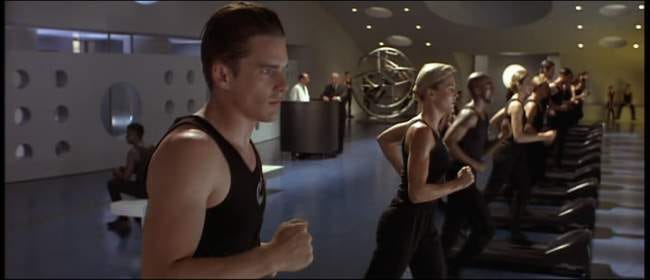Projections Deep Dive: The Game Model and "Player Fit"
Adding back our own team effects into the target player projections
Previously On “Absolute Unit”
We were lifting the financial valuation framework over to player recruitment in a football club. At a high level, the financial world estimates the “value” of an asset as (i) the projected future cash flows it generates, which are then discounted, to price it relative to the amount, risk, and timing of similar assets' cash flows using (ii) the concept of a “required rate of return.”
To (i) project future cash flows the basic steps we agreed on were:
Obtain relevant and reliable accounting records of historical results, which are (1a) denominated in the unit of value that you care about (in our case “marginal goal difference contribution”).
Adjust the historical results for noisy, non-recurring items to create “pro-forma historical results.”
Take those pro-forma historical results and project them forward into the future in some kind of documented, evidenced-based manner based on the information publicly available.
Layer in any proprietary information you may have related to the thing being valued.
Apply individual judgments not already included above.
Last Week’s “Team Performance Model”
In the last post we borrowed some stuff from Michael Porter to explore a network of interdependent activities and inputs that together comprise the “value chain” of a soccer operations department, this department itself one component in a broader “value chain” of a profit-seeking football club, with the soccer operations department consuming and investing in resources to generate marginal goal difference, and the football club consuming resources and combining those with the goal difference generated by the soccer operations department to create brand equity and generate profit.
As a basic concept I sketched out the following “Team Performance” model, and described how when it comes to the transfer market and projecting the individual contributions of a target player within a framework that tracks towards the total team goal difference objective, it’s theoretically necessary to estimate the impacts of the relationships between any of these activities and the individual team-agnostic player contribution projections we had already generated.
While several activities came to mind that we might want to further explore and adjust our player projections for, the relationship between the manager’s game model or tactical idea of his team’s style and the target player’s unique play style or skill set seemed like one to explore in further detail, with the goal of “re-levering” the player projections which we had already stripped of the player’s prior team effects.
What is a “Game Model?”
A “Game Model” broadly defined is a manager’s idea of the game and how his team should go about playing it. In practice, it is a living, breathing articulation (and implementation) of the team’s tactics, consisting of an overall Idea and then cascading levels of principles, sub-principles and instructions for position groupings (e.g. “the back line” or “the right flank”) and individual player roles (e.g. right wing back) respectively, and importantly these cascading sub-principles and instructions (picture these as rows) likely differ based on the specific moment or situation in the game (picture these as columns), such that one way to visualize this coherent game model is a matrix of concepts and instructions for different phases of the game and situations the team and the players might find themselves in.
If you’ll indulge me, you might imagine a cube, boxed in by these matrices . The three currently visible sides of the cube might represent the game model for when your team is in possession, including one side showing team-level principles as rows, another with sub-principles for player groupings as the rows, and yet another for specific player instructions as the rows, with the columns for all three sides representing phases or situations of the game. You might mentally turn the cube to see the other three sides are the mirror of those you’ve already seen but describe the game model for when the team is out of possession rather than in possession. You might notice that all six sides of this cube connect to each other and cannot be separated.
*snaps back to reality*
What does it do?
The purposes of the game model are myriad, but perhaps the primary objective is to cement for the coaching staff and the players not only the holistic vision of the team’s strategy, but also the basics of what is required of them in different situations, such that when they find themselves in improvisational moments, they do not waste precious milliseconds thinking about their responsibilities or guessing at what their teammates are going to do. Instead, like a musician who knows where the notes are on the instrument, players might intuitively know the plan and trust that their teammates know the plan, such that those precious milliseconds receiving a pass or reacting to a transition moment (whether it be towards defense or towards attack) are directed towards creativity and ingenuity to solve problems as a team as they arise. Improvisation within the basic rhythm and key signature of the song.
Game models might also be attached via strong links to a manager’s plan for team training, or “Periodization” (one such linkage you might spot if you squint at the Team Performance Model graphic at the beginning of this post). In fact, when you read about game models, you often read not only about tactical concepts but about how teams train the game model. So much interlinking.
https://jonasmunkvold.selz.com/blog/the-making-of-a-game-model
https://spielverlagerung.com/2016/03/07/how-to-create-a-game-model/
But why do we care for player recruitment?
Because the game model cascades from the broad principles down to the player-level instructions for each situation in the game with strong linkages all the way down (and around), one ultimate product of a good game model is a detailed description of the types of things the manager wants specific player roles to attempt and to accomplish. While principles often involve a degree of flexibility depending on a player’s read of the game, in the end many managers have very specific ideas about the types of chances they want their team to work towards and how they want to create those chances in attack. Many managers have very specific ideas about how they want to organize buildup and the types of risks they want their players to take in different parts of the field. Many managers have very specific ideas about how they want their players to react in transition, whether that be from defense to attack or from attack to defense. And the ideas the manager defends for each phase of the game should ideally compliment one another because soccer is continuous (remember that cube?)
While some of this can be developed and/or trained into the players (see “Periodization” above), in the end there are certain attributes or skills that are so critical to certain “play styles” derived from role requirements in the game model, that a team probably wants to recruit for them. That piece is nothing new. You’ve surely read countless times the general importance of recruiting players that fit your club’s profile. But more germane to this specific newsletter, if these “play styles” are so important as to demand clubs keep them in mind when recruiting, then might they have an impact on our ultimate projection of a target player’s contribution to team goal difference over his proposed contract term, especially if we’ve done the work of stripping out his prior team effect and projecting forward his growth and development? Obviously yes, I’ve probably already said this.
As some homework, I recommend going back and reading John Muller’s very fun Statsbomb piece from August 2019 entitled “Barcelona’s Griezmann Signing Makes No Damn Sense.” This is a striking illustration of something at least adjacent to how a team-agnostic projection of a player’s contribution can be inadequate. John shows how Griezmann, who was surely a great player in absolute terms, was a bad fit for Barcelona, based on the types of things Barcelona was trying to do compared to the types of things Griezmann had been successful doing at Atletico Madrid, and how even the things that might’ve fit in just fine at Barca were the exact types of things that Messi was already doing and in the same parts of the pitch, and so could you really just add Griezmann’s output to Barcelona’s output and call it a day (?), and of course no, you couldn’t.
To step it through the five steps of the player projection process, inclusive of the five layers of step 3 that we’ve been walking through, you could’ve taken Antoine Griezmann’s historical results (step 1), and removed out the noise of set pieces, penalties, and finishing (step 2), then in the (step 3) layers, you might have used some blunt math to strip out the Athletico-ness of his historical results, and then projected his results forward based on his age and other factors, but you’d still have been left with a projection of his performance that was agnostic of the fact that he needed to fit into the Barcelona system and play nice with Lionel Messi.
As we’ve discussed before, this sort of stuff is a mess to model, but for sure analysts are working on this right now behind closed doors, and at the very least, we might as a placeholder suggest something like:
When projecting a target player’s contributions, consider some of the key types of attacking moves and defensive qualities that the manager’s game model demands.
Look for evidence in the event data and in the scouting tapes of the player attempting and or achieving these types of activities and characteristics regularly.
If the player does not have a history doing these things, that’s fine. Perhaps, they are so good that their skills will translate well enough to a new set of instructions and it’ll work out and you have a strong reason to think it will, but consider haircutting your team-agnostic projections based on this risk. If the player has a strong history of doing these things (that is to say you can verify a strong match between the “play style” and the game model requirements for the position), consider modestly increasing your team-agnostic projections. Lastly, recognize that most often you’ll fall somewhere in between those two, with the largest adjustments in either direction most likely only appearing in cases of managers with extremely pronounced game models or play styles.
Example: The Flanks
One way that a manager’s game model might crystalize at the player and player group levels is via simple rule-of-thumb instructions contingent on the situation at hand. These alone are not “the game model,” but these rule-of-thumb guides instead sitting atop broader sub-principles, and principles and an overall idea might just be. For example in the finishing phase, a manager might have preferences around the types of finishing sequences and attacking moves he likes his teams to work towards. At the player group level — say the partnership between the right fullback and the right attacking midfielder — the manager may have a certain general positional or spacing concept he wants the players to maintain. Let me see here…
[author pauses to put tactics imposter hat on]
In the scenario where a manager’s team has strong possession of the ball and is probing to create an attack, he might as an example want the wide right midfielder to stay compact with the other attacking players to receive the ball in more valuable/dangerous areas, and he might want the fullback to overlap to the player’s right to maintain the threat of width. Three examples:
From here, one manager might have a preference that if the fullback receives a ball out wide (with his partner right-sided midfielder tucked more central), that he cross the ball into the box, with other groups of players having been given basic instructions for this situation to occupy dangerous areas in the box and to occupy dangerous counter-press areas, anticipating the defense clearing said cross. Instructions to the fullback might suggest that he cross it in if he has a step and sees targets, otherwise to recycle the ball to the nearest midfielder.
But another manager, might have a preference that if the fullback receives a ball out wide (with his partner right-sided midfielder tucked more central), that above all he attempt to beat the nearest defender to the box or to the end-line (likely both) and look for a cutback on the floor to the nearest midfielder sprinting to the center of the box, or to another late arriving player. If the at the outset of this sequence, the spacing appears as though a fullback occupying such initial width would not be able to win such a duel, perhaps other players are instructed not to play the ball out wide to him. In the scenario where the fullback receives the ball wide but this move is closed off, perhaps the fullback is asked to recycle possession as a plan B, with lofted crosses largely de-emphasized or excised from the team’s arsenal of finishing sequences.
Still another manager, might have a preference that the fullback underlap the right-sided attacking midfielder and occupy the right half space to connect more players together in the center, the midfielder rather than the fullback now occupying the right flank and threatening width, with any combination of crosses and take-ons preferred.
What this episode is trying to make clear is that quite obviously, the different preferences above ask different things of players in different roles. When targeting a right fullback signing for next season, the sporting director may have narrowed down his search to two realistic options, and he would be wise to consider the linkage between his manager’s game model and the play styles of the two target players. If both target players have similar team-agnostic marginal goal difference projections over the anticipated contract term (based on the layers we’ve walked through to date), but one player has a strong history of creating surplus output for his teams by receiving the ball in wide areas and lofting crosses into the box and the other a history of creating via dribble carries and cutbacks (and you can see this in the data or on film), then when adjusting the player’s projections over the next few years, you might imagine that the crossing fullback’s projections should be re-levered upwards (or held constant) for a prospective team who has hired the first manager, but hair-cutted for the prospective team who has hired the second, and vice versa, to say nothing of the other qualities the third manager might require of his fullbacks (and inversely for targeted wide players).
Within the System
Importantly, these matches or mismatches between a player’s style and a manager’s game model are only adjustments to the underlying contribution projections, and an analyst or a scout should have a clear, documented way of determining not just the direction of but the level of adjustment required for different situations. The team-specific adjustments might be the dog’s wagging tail, but the underlying team-agnostic (growth-estimated) contribution projections are still the dog.
Reasonable people might disagree, but my estimation is that a team that filters first on player style to match their manager’s game model, and then sorts on what’s left of modelled goal difference contribution will be eliminating plenty of potential valuable team goal difference contributors, those who might play a different style but are such capable players that they overcome these mismatches. You might imagine this “filter first” approach working out just fine for a team with an elite manager with an unshakeable singular vision of the game model and a wage/transfer budget that towers over their rivals, but if we take the “Absolute Unit” foundational assumptions seriously — that clubs are both 1) charged with optimizing or meeting a certain competitive output and 2) constrained as to the economic resources at their disposal — I fear that filtering on play-style first and only after casting our gaze towards output will miss the scale of the elements that contributes to marginal goal difference.
Conversely, I suspect zooming out to project team-agnostic goal different contribution first, and then, modestly adjusting the full population for style matches or mismatches against the team-specific game model, will give the department more firepower in terms of options towards putting together a winning team, firepower they will need ultimately when they run into the economic constraints that loom and the need for budget-rationing, the last-mile of this blog’s cycle which we grow closer and closer to finally confronting with every episode.
Asymmetry
A last somewhat esoteric point is just to acknowledge a somewhat broken parallelism between the second player contribution rate projection layer (“un-lever prior team effects”) and this fourth layer (“re-lever team-specific effects”).
You might expect the un-levering and re-levering to be a mirror image in terms of process or complexity, but this is not the case. To un-lever any effects of the player’s current or prior teams, I advocate for some kind of a top-down model based on high level characteristics of the team style or performance, or if more detailed, some sort of very automated and mathy build that takes into account the players’ teammates and their possible interactions towards the player’s past history of contributing to goal difference. And as you’ve read, over the last couple of posts, when we go to “re-lever” our own team-specific effects, there’s a whole host of additional adjustments to consider, model, evaluate, (the club insights to draw from here are potentially limitless) and that’s because there is an asymmetry between the amount of information we know about other clubs (an amount we should always work to maximize I should add), and the amount of information we naturally know about our own club. That is to say, we have proprietary information about our own team, obviously because we can go talk to the manager, the players, the medical team, watch the players in training, collect proprietary data on them, etc.
We first apply a gentle touch to un-lever the team effects from a player’s historical contributions, then we project it forward based on aging and development curves, then we take the projection and apply our own team-specific adjustments which are notably more rigorous, detailed, and precise to put forward the most complete projection of the player’s contribution to our team’s goal difference over the expected period of the contract we anticipate extending to the player. This broken parallelism is not a contradiction, but a reflection of real disparity in the accuracy and precision of information we have for other clubs and our own.
I’ve overstayed my welcome in this episode, so I’ll save the rest of these words for a later post on abstract transfer market economics, but I suspect it is this very asymmetry in information and play styles which would cause the transfer markets to clear player transactions, if we lived in a platonic football world where every team implemented the “Absolute Unit” framework and projected marginal goal difference contributions etc. Well, that and asymmetrical transfer budgets. We’re going to get to that.
As always, I appreciate your patience between posts.
Further Reading:
https://spacespacespaceletter.com/the-big-book-of-buildups-day-1-rotations/
https://statsbomb.com/2017/09/what-you-really-need-to-know-about-football-manager-recruitment/
https://www.statsperform.com/resource/clustering-playing-styles-in-the-modern-day-full-back/
https://www.americansocceranalysis.com/home/2020/3/3/clustering








